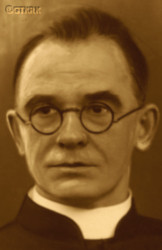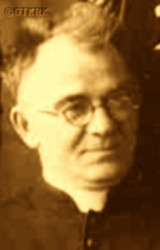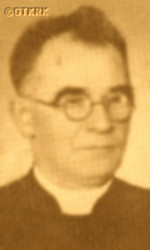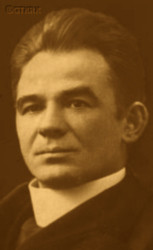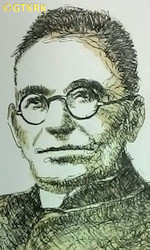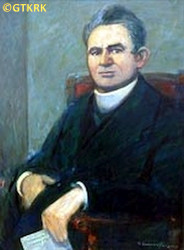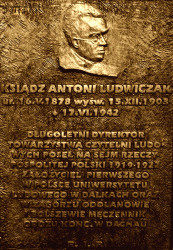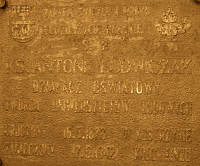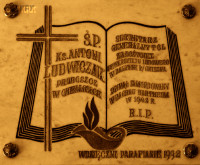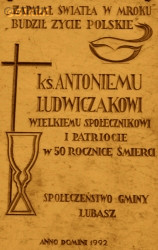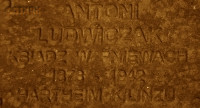Roman Catholic
St Sigismund parish
05-507 Słomczyn
85 Wiślana Str.
Konstancin deanery
Warsaw archdiocese, Poland
full list:
displayClick to display full list

searchClick to search full list by categories
wyświetlKliknij by wyświetlić pełną listę po polsku

szukajKliknij by przeszukać listę wg kategorii po polsku

Martyrology of the clergy — Poland
XX century (1914 – 1989)
personal data
surname
LUDWICZAK
forename(s)
Anthony John (pl. Antoni Jan)
forename(s)
versions/aliases
John (pl. Jan)
function
diocesan priest
creed
Latin (Roman Catholic) Church RCmore on
en.wikipedia.org
[access: 2014.09.21]
diocese / province
Gniezno and Poznań archdiocese (aeque principaliter)more on
www.archpoznan.pl
[access: 2012.11.23]
RC Military Ordinariate of Polandmore on
en.wikipedia.org
[access: 2014.12.20]
honorary titles
„Cross of Independence”more on
en.wikipedia.org
[access: 2019.02.02]
(17.09.1932)
„Polonia Restituta” Cross — 4th Class, Officer'smore on
en.wikipedia.org
[access: 2019.04.16]
(30.04.1925)
Silver „Academic Laurel” badge, Silver 2nd Class
(07.11.1936)
date and place
of death
18.05.1942

TA HartheimSchloss Hartheim „euthanasia” center
today: Alkoven, Eferding dist., Salzburg state, Austria
more on
en.wikipedia.org
[access: 2022.07.18]
alt. dates and places
of death
17.06.1942 (KL Dachau „death certificate” date)
details of death
During education (until 1900) in the Germ. Königliche Marien–Gymnasium (Eng. Royal Marian Gymnasium) in Poznań — today St Mary Magdalene High School — founder and member of the Polish clandestine, self‐educational Tomasz Zan Society. It happened at the time of the most severe Germanization in the Prussian partition of Poland, and in his Catholic school, where the majority of youth were Polish, there were 54 hours of German lessons per week, 130 hours of Latin, 72 hours of Greek, 38 hours of French and … 28 hours of Polish lessons in all grades, and the language of instruction was German.
In 1906‐1907, during the school strike of Polish children in the Prussian partition, led the children's protest in the school in Lubasz.
During World War I 1914‐1918 founded a Polish newspaper for Poles called up to serve in the German Imperial Army. Initiated the campaign „Polish Book in the Trenches for the Polish Soldier”, as a result of which 61,000 books, including prayer books, tens of thousands of religious pictures, 191,000 copies of newspapers and magazines were sent to the front, military hospitals, internment camps and POW camps — everywher, where there were Poles. Cooperated with the Red Cross organization — perhaps with the Polish section of the International Red Cross, established in 1915 in Geneva, because the Germans did not give consent to the establishment of a Polish branch of the German Red Cross. Despite this, Poznań doctors conducted clandestine medical courses and training — from 1915 organised also by the Poznań Rescue Committee, the establishment of which was approved by the Germans.
In the autumn of 1918 became a member of the clandestine Citizens' Committee in Pniewy — such committees in Germ. Provin Posen (Eng. Poznań Province) had begun to multiply since 07.1918. Was prob. the liaison with the clandestine Inter–Party Citizens' Committee, established in Poznań in 01.1916, bringing together Polish deputies to the Reichstag, the parliament of the German Empire.
After the abdication on 09.11.1918 of the German Emperor William II Hohenzollern; after the signing on 11.11.1918 by the Allies and the Germans, in a staff wagon in Compiègne, at the headquarters of French Marshal Ferdinand Foch, of the armistice and ceasefire — which de facto meant the end of World War I; and also after the Regency Council — operating in the so‐called Germ. Königreich Polen (Polish Kingdom), on the territory occupied by the Central Powers (Germany and Austria–Hungary) — transferred on 11.11.1918 supreme command over the army to Brigadier Joseph Piłsudski and appointed him Commander‐in‐Chief of the Polish Army, which meant the de facto rebirth of the Polish state, covering, however, only the Germ. Königreich Polen, i.e. the Polish territory under Russian rule until 1915, and excluding the lands of the Prussian partition; Greater Poland — as the Prussian Germ. Province of Posen — was still formally part of the German state. At that time, on 17.11.1918, the Citizens' Committee in Pniewy revealed itself and transformed into the People's Council — modelled on the Supreme People's Council NRL established in Poznań from the transformation of the Inter–Party Citizens' Committee — of which prob. became the chairman (at the same time, the Soldiers' and Workers' Council was prob. also established, with a German majority). The People's Council led to the establishment of the People's Guard, organised by members of the Polish Gymnastics Society „Sokół” in Pniewy, from then on constituting the stronghold of Polish power in the town and the foundation for the Greater Poland army (it was indispensable, as evidenced by the arrival of a detachment of German gendarmerie from Międzychód in Pniewy on 20.11.1918, in search of weapons collected by the People's Guard — nothing was found and the detachment left for home).
Was a delegate to the Polish District Parliament (Seym), which convened on 03‐05.12.1918 in Poznań, which expressed the will to create a united Polish state with access to the sea. At the same time, it recognized the NRL in Poznań as the sole and legal supreme authority of Poles in Germany. After returning to his parish, the Soldiers' and Workers' Council in Pniewy dissolved itself on 20.12.1918, leaving the People's Council as the only structure of power in the town.
On 27.12.1918, the Greater Poland Uprising broke out. Insurgent units were organized in Pniewy on 05‐16.01.1919, which then took part, among others, in battles in the area of Międzychód: contributing to the liberation of Sieraków, on 16.01.1919 near the village of Kamionna, twice — including on 01‐07.02.1919 — near Kolno village; and also in the battles around Zbąszyń. Was their chaplain. The uprising ended on 16.02.1919 with a truce in Trier, enforced by the victorious Entente states, by virtue of which the Polish insurgent Greater Poland Army was recognized as an allied army and a border was set, the crossing of which „German troops were forbidden”, leaving a large part of Greater Poland outside their influence. However, it was not until the Treaty of Versailles, concluded on 26.06.1919, that Greater Poland (including Międzychód) was formally granted to Poland.
At that time, took part — although Greater Poland was still formally part of the German state, and despite German protests — in the elections to the Polish Legislative Sejm, becoming its deputy. Was the MP when on 10.01.1920 the provisions of the Treaty of Versailles ‐ after the necessary ratifications — came into force and Greater Poland formally became part of the Polish state.
On 12.03.1920, appointed by the Minister of Foreign Affairs as the chairman of the Warmia Plebiscite Committee, which was to supervise Polish affairs before the plebiscite planned for 11.07.1920, which was to decide on the statehood of Warmia and Mazury. The plebiscite took place on time and ended in defeat for Poland — one of the reasons was the threat to the Polish state from the Russian offensive, which was then reaching the heart of Poland. Next co‐founded the Upper Silesia Defence Committee in Poznań ‐ before a similar plebiscite planned for that area.
After German and Russian invasion of Poland in 09.1939 and start of the World War II, after start of German occupation, arrested by the Germans on 02.11.1939.
Jailed in Inowrocław prison.
On 05.11.1939 moved to Świecie prison (in f. psychiatric hospital) and next on 08.11.1939 to Górna Grupa transit camp.
On 05.02.1940 transported to ZL Neufahrwasser in Gdańsk transit camp and from there on 08.02.1940 to KL Stutthof concentration camp.
Next on 09‐10.04.1940 moved to KL Sachsenhausen concentration camp.
Finally on 14.12.1940 transported to KL Dachau concentration camp and from there — totally exhausted — in a so‐called Germ. „Invalidentransport” (Eng. „Invalids' transport”) to TA Hartheim Euthanasia Center where murdered in a gas chamber.
According to the death certificate, prepared in KL Dachau, the „honest” otherwise German „medical doctors” and formalists — and at the same time, unrivaled fairy tale spinners — noted that the cause of death was Germ. „Versagen des Kreislaufes bei Herzmuskelentartung” (Eng. „Failure of the circulatory system with diabetic dysentery”).
prisoner camp's numbers
22576Click to display source page (KL DachauClick to display the description)
cause of death
extermination: gassing in a gas chamber
perpetrators
Germans
sites and events
TA HartheimClick to display the description, «Aktion T4»Click to display the description, KL DachauClick to display the description, KL SachsenhausenClick to display the description, KL StutthofClick to display the description, ZL NeufahrwasserClick to display the description, DL Ober GruppeClick to display the description, VSH SchwetzClick to display the description, Świecie (Institute)Click to display the description, InowrocławClick to display the description, 02.11.1939 arrests (Inowrocław)Click to display the description, «Intelligenzaktion»Click to display the description, Reichsgau Danzig‐WestpreußenClick to display the description, Ribbentrop‐MolotovClick to display the description, Pius XI's encyclicalsClick to display the description, Greater Poland UprisingClick to display the description, Thomas Zan SocietiesClick to display the description
date and place
of birth
16.05.1878Birth certification on:
photos.szukajwarchiwach.gov.pl
[access: 2025.08.19]

Kostrzyntoday: Kostrzyn gm., Poznań pov., Greater Poland voiv., Poland
more on
en.wikipedia.org
[access: 2021.12.19]
parents
LUDWICZAK John
🞲 ?, ? — 🕆 ?, ?

PAWELLA Salome
🞲 ?, ? — 🕆 ?, ?
presbyter (holy orders)
ordination
13.12.1903

Gnieznotoday: Gniezno urban gm., Gniezno pov., Greater Poland voiv., Poland
more on
en.wikipedia.org
[access: 2021.12.18]
positions held
1938 – 1939
parish priest — Chełmcetoday: Kruszwica gm., Inowrocław pov., Kuyavia‐Pomerania voiv., Poland
more on
pl.wikipedia.org
[access: 2021.07.18] ⋄ St Catherine the Virgin and Martyr RC parish ⋄ Kruszwicatoday: Kruszwica gm., Inowrocław pov., Kuyavia‐Pomerania voiv., Poland
more on
en.wikipedia.org
[access: 2021.07.18] RC deanery
c. 1925 – 1938
priest — Dalkitoday: neighborhood in Gniezno, Gniezno urban gm., Gniezno pov., Greater Poland voiv., Poland
more on
en.wikipedia.org
[access: 2021.12.18] ⋄ RC chapel (public oratory) ⋄ Gnieznotoday: Gniezno urban gm., Gniezno pov., Greater Poland voiv., Poland
more on
en.wikipedia.org
[access: 2021.12.18], St Lawrence the Martyr RC parish ⋄ Gnieznotoday: Gniezno urban gm., Gniezno pov., Greater Poland voiv., Poland
more on
en.wikipedia.org
[access: 2021.12.18] RC deanery
1921 – 1938
director — Dalkitoday: neighborhood in Gniezno, Gniezno urban gm., Gniezno pov., Greater Poland voiv., Poland
more on
en.wikipedia.org
[access: 2021.12.18] ⋄ Catholic People's University — also: founder of c. 28 folk universities, i.a. in Dalki (the first one in Poland), Zagórze in Kashubia (1926), Bolszewo and Odolanów on the border with German Silesia (1927)
1918 – 1933
director — People's Reading Rooms Society TCL — in 1922, within the borders of the reborn Polish state, the number of public libraries was 1,360, with 204,239 volumes in their collections
1919 – 1922
parliamentary deputy — Seym i.e. Parliament (Legislative), Second Polish Republic — elected as the president of the National People's Party, founded in Poznań, of which was a co‐organizer, then vice‐president, and from 21.04.1919 president
1912 – 1918
General secretary — People's Reading Rooms Society TCL — organizer and founder of several dozen libraries and reading rooms under the auspices of the Society, not only in Greater Poland, but throughout the Prussian partition (Silesia, Pomerania), as well as among Polish economic emigrants throughout Germany
1912 – c. 1924
prebendary — Pniewytoday: Pniewy gm., Szamotuły pov., Greater Poland voiv., Poland
more on
en.wikipedia.org
[access: 2021.07.18] ⋄ Holy Spirit RC church ⋄ St Lawrence the Martyr RC parish ⋄ Lwówektoday: Lwówek gm., Nowy Tomyśl pov., Greater Poland voiv., Poland
more on
en.wikipedia.org
[access: 2020.11.27] RC deanery
1912
vicar — Psarskietoday: Pniewy gm., Szamotuły pov., Greater Poland voiv., Poland
more on
en.wikipedia.org
[access: 2021.07.18] ⋄ Blessed Virgin Mary of the Assumption RC parish ⋄ Lwówektoday: Lwówek gm., Nowy Tomyśl pov., Greater Poland voiv., Poland
more on
en.wikipedia.org
[access: 2020.11.27] RC deanery
1910 – 1911
vicar — Ostrów Wielkopolskitoday: Ostrów Wielkopolski urban gm., Ostrów Wielkopolski pov., Greater Poland voiv., Poland
more on
en.wikipedia.org
[access: 2021.06.07] ⋄ St Stanislav the Bishop and Martyr RC parish ⋄ Ostrów Wielkopolskitoday: Ostrów Wielkopolski urban gm., Ostrów Wielkopolski pov., Greater Poland voiv., Poland
more on
en.wikipedia.org
[access: 2021.06.07] RC deanery — also: activist of the Catholic Society of Polish Workers
1908 – 1910
vicar — Ostrzeszówtoday: Ostrzeszów gm., Ostrzeszów pov., Greater Poland voiv., Poland
more on
en.wikipedia.org
[access: 2021.05.30] ⋄ Blessed Virgin Mary of the Assumption RC parish ⋄ Ostrzeszówtoday: Ostrzeszów gm., Ostrzeszów pov., Greater Poland voiv., Poland
more on
en.wikipedia.org
[access: 2021.05.30] RC deanery — also: activist of the Catholic Society of Polish Workers
1907 – 1908
vicar — Buktoday: Buk gm., Poznań pov., Greater Poland voiv., Poland
more on
en.wikipedia.org
[access: 2021.06.20] ⋄ St Stanislav the Bishop and Martyr RC parish ⋄ Buktoday: Buk gm., Poznań pov., Greater Poland voiv., Poland
more on
en.wikipedia.org
[access: 2021.06.20] RC deanery
1904 – 1907
vicar — Lubasztoday: Lubasz gm., Czarnków/Trzcianka pov., Greater Poland voiv., Poland
more on
en.wikipedia.org
[access: 2021.06.20] ⋄ Nativity of the Blessed Virgin Mary RC parish ⋄ Czarnkówtoday: Czarnków gm., Czarnków/Trzcianka pov., Greater Poland voiv., Poland
more on
en.wikipedia.org
[access: 2021.06.20] RC deanery — also: organizer of „Farmer” cooperative
till 1903
student — Gnieznotoday: Gniezno urban gm., Gniezno pov., Greater Poland voiv., Poland
more on
en.wikipedia.org
[access: 2021.12.18] ⋄ philosophy and theology, Archbishop's Practical Theological Seminary (Lat. Seminarium Clericorum Practicum)
from 1900
student — Poznańtoday: Poznań city pov., Greater Poland voiv., Poland
more on
en.wikipedia.org
[access: 2021.07.18] ⋄ philosophy and theology, Archbishop's Theological Seminary (Collegium Leoninum)
founder and editor of „Friend of Children” (1911‐1917) and „Friend of Youth” (1911‐1915) magazines
from 1914
regular member — Poznańtoday: Poznań city pov., Greater Poland voiv., Poland
more on
en.wikipedia.org
[access: 2021.07.18] ⋄ Historical Committee, Friends of Sciences Society
social and political activist, i.a. 1906‐1918 member of the National League; 1919 co‐organizer, vice‐president and president of the National People's Party in Poznań; activist of the Pomeranian–Poznań Group of the Polish Librarians Association; treasurer of the Society of Writers and Journalists in Poznań; member of the Polish Bibliophiles Association; from 1927 vice‐president of the executive department of the Union of Polish Educational Societies; president of the Greater Poland branch of the Association of Participants in the Struggle for the Polish School, established in 1933
others related
in death
CIEMNIAKClick to display biography Louis, DEMSKIClick to display biography Vladislav, FARULEWSKIClick to display biography Thaddeus, GOTOWICZClick to display biography Louis, KOMPFClick to display biography January Sigismund, KUBICKIClick to display biography Telesphorus, KUBSKIClick to display biography Stanislav, ŁÓJClick to display biography John, MATUSZEWSKIClick to display biography Francis Adam, MĄKOWSKIClick to display biography John, MULLERClick to display biography Joseph Stanislav Kostka, NIEMIRClick to display biography Joseph, POMIANOWSKIClick to display biography Vladislav, SCHOENBORNClick to display biography Steven Charles Francis, SKOWRONClick to display biography Casimir, STREHLClick to display biography Mieczyslav, SZUKALSKIClick to display biography John Wladysław, WĄSOWICZClick to display biography Sigismund, WŁODARCZYKClick to display biography Ignatius
sites and events
descriptions
TA Hartheim: From 05.1940, in the Germ. Tötungsanstalt (Eng. Killing/Euthanasia Center) TA Hartheim, at the Schloss Hartheim castle in Alkoven in Upper Austria, belonging to KL Mauthausen‐Gusen complex of concentration camps, as part of «Aktion T4» program, the Germans murdered victims — people mentally retarded and disabled — in gas chambers with carbon monoxide. Till 24.08.1941 and the formal end of the «Aktion T4» program, c. 18,000 people were murdered in TA Hartheim. In 04.1941 the program was extended to include concentration camp prisoners. Most, if not all, of the murdered clergy from the KL Dachau concentration camp were taken to TA Hartheim in the so‐called Germ. „Invalidentransport” (Eng. „transport of invalids”), prisoners who were sick and, according to the Germans, „unable to work” (initially under the pretext of transfer to a better camp) — after the formal end of «Aktion T4» as part of the program codenamed «Aktion 14 f 13». It is estimated that at this stage — until 11.12.1944 — c. 12,000 prisoners were gassed at TA Hartheim.
Note: The dates of death of victims murdered in Schloss Hartheim indicated in the „White Book” are the dates of deportations from the last concentration camp the victims where held in. The real dates of death are unknown — apart from c. 49 priests whose names were included in the niem. „Invalidentransports”, but who did not arrive at TA Hartheim. Prob. perished on the day of transport, somewhere between KL Dachau and Munich, and their bodies were thrown out of the transport and cremated in Munich. The investigation conducted by Polish Institute of National Remembrance IPN concluded, that the other victims were murdered immediately upon arrival in Schloss Hartheim, bodies cremated and the ashes spread over local fields and into Danube river. In order to hide details of the genocide Germans falsified both dates of death (for instance those entered into KL Dachau concentration camp books, which are presented in „White Book” as alternative dates of death) and their causes. (more on: ipn.gov.plClick to attempt to display webpage
[access: 2019.05.30], en.wikipedia.orgClick to attempt to display webpage
[access: 2019.05.30])
«Aktion T4»: German state euthanasia program, systematic murder of people mentally retarded, chronically, mentally and neurologically ill — „elimination of live not worth living” (Germ. „Vernichtung von lebensunwertem Leben”). At a peak, in 1940‐1941, c. 70,000 people were murdered, including patients of psychiatric hospitals in German occupied Poland — German formalists noted then that, among others, „performing disinfection [i.e. gassing] of 70,273 people with a life expectancy of up to 10 years saved food in the amount of 141,775,573.80 Deutschmark”. From 04.1941 also mentally ill and „disabled” (i.e. unable to work) prisoners held in German concentration camps were included in the program — denoted then as «Aktion 14 f 13». C. 20,000 inmates were then murdered, including Polish Catholic priests held in KL Dachau concentration camp, who were murdered in Hartheim gas chambers. The other „regional extension” of «Aktion T4» was «Aktion Brandt» program during which Germans murdered chronically ill patients in order to make space for wounded soldiers. It is estimated that at least 30,000 were murdered in this program. (more on: en.wikipedia.orgClick to attempt to display webpage
[access: 2014.10.31])
KL Dachau: KL Dachau in German Bavaria, set up in 1933, became the main German Germ. Konzentrationslager (Eng. concentration camp) KL for Catholic priests and religious during World War II: On c. 09.11.1940, Reichsführer‐SS Heinrich Himmler, head of the SS, Gestapo and German police, as a result of the Vatican's intervention, decided to transfer all clergymen detained in various concentration camps to KL Dachau camp. The first major transports took place on 08.12.1940. In KL Dachau Germans held approx. 3,000 priests, including 1,800 Poles. The priests were forced to slave labor in the Germ. „Die Plantage” — the largest herb garden in Europe, managed by the genocidal SS, consisting of many greenhouses, laboratory buildings and arable land, where experiments with new natural medicines were conducted — for many hours, without breaks, without protective clothing, no food. They slaved in construction, e.g. of camp's crematorium. In the barracks ruled hunger, freezing cold in the winter and suffocating heat during the summer, especially acute in 1941‐1942. Prisoners suffered from bouts of illnesses, including tuberculosis. Many were victims of murderous „medical experiments” — in 11.1942 c. 20 were given phlegmon injections; in 07.1942 to 05.1944 c. 120 were used by for malaria experiments. More than 750 Polish clerics where murdered by the Germans, some brought to TA Hartheim euthanasia centre set up in Schloss Hartheim in Austria and murdered in gas chambers. At its peak KL Dachau concentration camps’ system had nearly 100 slave labour sub‐camps located throughout southern Germany and Austria. There were c. 32,000 documented deaths at the camp, and thousands perished without a trace. C. 10,000 of the 30,000 inmates were found sick at the time of liberation, on 29.04.1945, by the USA troops… (more on: www.kz-gedenkstaette-dachau.deClick to attempt to display webpage
[access: 2013.08.10], en.wikipedia.orgClick to attempt to display webpage
[access: 2016.05.30])
KL Sachsenhausen: In Germ. Konzentrationslager (Eng. concentration camp) KL Sachsenhausen, set up in the former Olympic village in 07.1936, hundreds of Polish priests were held in 1940, before being transported to KL Dachau. Some of them perished in KL Sachsenhausen. Murderous medical experiments on prisoners were carried out in the camp. In 1942‐1944 c. 140 prisoners slaved at manufacturing false British pounds, passports, visas, stamps and other documents. Other prisoners also had to do slave work, for Heinkel aircraft manufacturer, AEG and Siemens among others. On average c. 50,000 prisoners were held at any time. Altogether more than 200,000 inmates were in jailed in KL Sachsenhausen and its branched, out of which tens of thousands perished. Prior to Russian arrival mass evacuation was ordered by the Germans and c. 80,000 prisoners were marched west in so‐called „death marches” to other camps, i.e. KL Mauthausen‐Gusen and KL Bergen‐Belsen. The camp got liberated on 22.04.1945. After end of armed hostilities Germans set up there secret camp for German prisoners and „suspicious” Russian soldiers. (more on: en.wikipedia.orgClick to attempt to display webpage
[access: 2018.11.18])
KL Stutthof: In German Germ. Konzentrationslager (Eng. concentration camp) KL Stutthof (then in Eastern Prussian belonging to Germany, today: Sztutowo village) concentration camp, that Germans started to build on 02.09.1939, a day after German invasion of Poland and start of the World War II, Germans held c. 110,000‐127,000 prisoners from 28 countries, including 49,000 women and children. C. 65,000 victims were murdered and exterminated. In the period of 25.01‐27.04.1945 in the face of approaching Russian army Germans evacuated the camp. When on 09.05.1945 Russians soldiers entered the camp only 100 prisoners were still there. In an initial period (1939‐1940) Polish Catholic priests from Pomerania were held captive there before being transported to KL Dachau concentration camp. Some of them were murdered in KL Stutthof or vicinity (for instance in Stegna forest). Also later some Catholic priests were held in KL Stutthof. (more on: stutthof.orgClick to attempt to display webpage
[access: 2018.11.18], en.wikipedia.orgClick to attempt to display webpage
[access: 2013.07.06])
ZL Neufahrwasser: Germ. Zivilgefangenenlager (Eng. POW camp for civilians) organized by the Germans on the day of the outbreak of the war, on 01.09. 1939, in Gdańsk ‐ Nowy Port (New Port), in former artillery barracks belonging to Poland, for Poles from Pomerania arrested as part of the «Intelligenzaktion» action — extermination of Polish intelligentsia. Prisoners from ZL Neufahrwasser — 2,702 people were identified, but it is estimated that c. 10,000 arrestees passed through the camp — were sent to the KL Stutthof concentration camp or directly to the places of extermination. The camp operated till 01.04.1940 (more on: stutthof.orgClick to attempt to display webpage
[access: 2013.08.10], ofiaromwojny.republika.plClick to attempt to display webpage
[access: 2013.12.04])
DL Ober Gruppe: From 10.1939 till c. 04.1940, in the Divine Word Missionaries SVD Congregation's house in Górna Grupa — taken over by the Germans after the suspension of the activities of the Minor Seminary run by the friars, and their internment, and the repurposing of the building for military purposes — the Germans organized a Germ. Durchgangslager (Eng. Transit camp), i.e. DL Ober Gruppe, for Poles, including 95 Polish clergy, from the Świecie, Bydgoszcz, Chełmno, Grudziądz, and Starogard Gdański regions in Pomerania. C. 50 of them — detained as part of the Germ. «Intelligenzaktion» (Eng. „Action Intelligence”), i.e. the extermination of the Polish intelligentsia and leadership classes in Pomerania — perished, a significant number of them murdered at the execution sites in Mniszek‐Grupa. In the same place in 1945 Russians set up a concentration camp for Germans, among whom two priests perished. (more on: pl.wikipedia.orgClick to attempt to display webpage
[access: 2021.12.19], www.kpbc.ukw.edu.plClick to attempt to display webpage
[access: 2013.12.27])
VSH Schwetz: German Germ. Volksdeutscher Selbstschutzhaft (Eng. Volksdeutscher Selbstschutz custody) VSH founded in 09.1939 by the genocidal German paramilitary organization Volksdeutscher Selbstschutz in Świecie nad Wisłą. The decision to create Selbstschutz in the Polish lands occupied by German troops was made in Berlin on 08‐10.09.1939 at a conference headed by Reichsführer‐SS Heinrich Himmler (the formal order bears the date 20.09.1939), and the chaotically formed units were directly subordinated to the officers of the genocidal SS organization. The Germans captured Świecie on 03.09.1939. As part of the «Intelligenzaktion», i.e. the extermination of Polish intelligentsia and leadership classes, arrests of local Poles began immediately. The victims were imprisoned and held in terrible conditions in the cells of the court prison in Świecie, empty pavilions of the National Pomeranian Psychiatric Institution (especially after 22.10.1939, when the Germans murdered most of its patients as part of «Aktion T4»), distillery buildings in Luszkówko, prison cells in Nowe nad Wisłą and in the buildings of the Divine Word Missionaries institute in Górna Grupa. They were subjected to torture and harassment. From c. 08‐09.10.1939 mass executions began — the day before the first execution in Świecie, the Germ. Gauleiter (Eng. district governor) of the German National Socialist Party NSDAP in Gdańsk, later the Germ. Reichsstatthalter (Eng. Reich Governor) of the Germ. Reichsgau Danzig–Westpreußen (Eng. Reich District Gdańsk–West Prussia), appeared and called on all local Germans to strictly carry out the orders, adding „even if it meant bathing in blood up to the necks” — i.a. at the Jewish cemetery in Świecie, as well as in the forests near the village of Mniszek and the military training ground in the village of Grupa. Dozens of Catholic priests passed through the prison, of whom c. 50 died: 20 were murdered by the Germans in Mniszek, and the rest perished in German concentration camps. (more on: pl.wikipedia.orgClick to attempt to display webpage
[access: 2021.12.19])
Świecie (Institute): In the autumn of 1939 Germans— as part of «Aktion T4» program — murdered almost all patients of the National Pomeranian Psychiatric Institute in Świecie. On 15‐21.10.1939 c. 1,000 patients were murdered in the forest by Mniszek village, in groups of 60. Among the victims were 120 children. And hospital’s Polish director, Joseph Bednarz PhD, who stayed with his patients till the end. The victims were pushed — three aside — into specially prepared ditches and shot by the members of the genocidal German SS‐Wachsturmbann „Eimann” unit from machine guns. C. 300 patients were transported to Kocborowo psychiatric hospital and murdered later in Szpęgawsk forest. (more on: ipn.gov.plClick to attempt to display webpage
[access: 2015.05.09])
Inowrocław: German prison and detention center at Pakoska Str. (today Narutowicza Str.). In 1939, the Germans held there hundreds of Poles from Inowrocław and the surrounding area, arrested as part of the «Intelligenzaktion» program — the physical extermination of the Polish intelligentsia and leadership classes. By 11.1939, 546 of them were murdered in the prison and the surrounding area (e.g. in Rożniaty and Zajezierze), including 56 people on the night of 22‐23.10.1939, the murder carried out after the collective libation of the Germans, which the German landrat, i.e. the occupying district official, a certain Hirschfeld, was said to have initiated by saying: „well, now we will go and shoot the Poles”. Later, it was also a place of execution for many Poles. After the Russian occupation began in 1945, the communist prison, also for women. (more on: www.inowroclawfakty.plClick to attempt to display webpage
[access: 2013.05.19])
02.11.1939 arrests (Inowrocław): On c. 01.11.1939 Germans „invited” local priests from Inowrocław and vicinity for a meeting on 02.11.1939 to „discuss terms and condition of collaboration with new authorities”. All present — 39 priests — were arrested on the spot and sent to concentration camps and execution sites.
«Intelligenzaktion»: German: «Intelligenzaktion» (English: „Intelligence Action”) — a German program of extermination of the Polish elite, mainly the intelligentsia and leadership layers, carried out from the beginning of the occupation in w 09.1939 to 04.1940, mainly in territories directly annexed to Germany, but also in the so‐called Germ. Generalgouvernement (Eng. General Governorate), where it was called «AB‐aktion». In the first phase, immediately after the beginning of the German occupation, during military operations carried out by the Germ. Wehrmacht (Eng. Armed Forces) and the genocidal units of the Germ. Einsatzgruppen (Eng. Operational Groups) of the Germ. Sicherheitspolizei (Eng. Security Police), i.e. SiPo, and Germ. Sicherheitsdienst des Reichsführers SS (Eng. Security Service of the Reichsführer SS), i.e. SD, organized by the Germ. Reichssicherheitshauptamt (Eng. Reich Main Security Office), i.e. RSHA, which followed the troops, carried out under the Germ. Unternehmen „Tannenberg” (Eng. Operation „Tannenberg”) — based on the so‐called Germ. Sonderfahndungsliste (Eng. Special Wanted Lists), i.e. proscription lists of Poles considered particularly dangerous to the Third Reich, prepared by the Zentralstelle II/P (Polen) unit of the German RSHA. Later, implemented by the German civilian occupation authorities and the genocidal unit of the Germ. Volksdeutscher Selbstschutz (Eng. Ethnic Germans Self‐Defense), whose members were Germ. Volksdeutsche (Eng. Ethnic Germans), i.e. representatives of the German minority in Poland. According to various sources, these lists, at the beginning of 09.1939, could have contained the details of 61,000—88,000 „dangerous” Poles — although these figures cannot be confirmed. In total, during this genocide, c. 50,000 teachers, Catholic priests, representatives of the landed gentry, freelancers, social and political activists, and retired military personnel were systematically and methodically murdered. Another 50,000 were sent to concentration camps, where only a negligible percentage survived. (more on: en.wikipedia.orgClick to attempt to display webpage
[access: 2014.10.04])
Reichsgau Danzig‐Westpreußen: After the Polish defeat in the 09.1939 campaign, which was the result of the Ribbentrop‐Molotov Pact and constituted the first stage of World War II, and the beginning of German occupation in part of Poland (in the other, eastern part of Poland, the Russian occupation began), the Germans divided the occupied Polish territory into five main regions (and a few smaller). The largest one was transformed into Germ. Generalgouvernement (Eng. General Governorate), intended exclusively for Poles and Jews and constituting part of the so‐called Germ. Großdeutschland (Eng. Greater Germany). Two were added to existing German provinces. From two other separate new provinces were created. Vistula Pomerania region was one of them, incorporated into Germany on 08.10.1939, by decree of the German leader Adolf Hitler (formally came into force on 26.10.1939), and on 02.11.1939 transformed into the Germ. Reichsgau Danzig‐Westpreußen (Eng. Reich District of Gdańsk‐West Prussia) province, in which the law of the German state was to apply. The main axis of the policy of the new province, the territory of which the Germans recognized as the Germ. „Ursprünglich Deutsche” (Eng. „natively German”), despite the fact that 85% of its inhabitants were Poles, was Germ. „Entpolonisierung” (Eng. „Depolonisation”), i.e. forced Germanization. C. 60,000 Poles were murdered in 1939‐1940, as part of the Germ. „Intelligenzaktion”, i.e. extermination of Polish intelligentsia and ruling classes, in c. 432 places of mass executions — including c. 220 Polish Catholic priests. The same number were sent to German concentration camps, from where few returned (over 300 priests were arrested, of whom c. 130 died in concentration camps). C. 124,000‐170,000 were displaced, including c. 90,000 to the Germ. Generalgouvernement. Poles were forced en masse to sign the German nationality list, the Germ. Deutsche Volksliste DVL. Polish children could only learn in German. It was forbidden to use the Polish language during Catholic Holy Masses and during confession. Polish landed estates were confiscated..To further reduce the number of the Polish population, Poles were sent to forced labor deep inside Germany. The remaining Poles were treated as low‐skilled labor, isolated from the Germans and strictly controlled — legally, three or three of them could only meet together, even in their own apartments. Many were conscripted into the German Wehrmacht army. After the end of hostilities of World War II, the overseer of this province, the Germ. Reichsstatthalter (Eng. Reich Governor) and the Germ. Gauleiter (Eng. district head) of the German National Socialist Party, Albert Maria Forster, was executed. (more on: en.wikipedia.orgClick to attempt to display webpage
[access: 2024.06.24])
Ribbentrop‐Molotov: Genocidal Russian‐German alliance pact between Russian leader Joseph Stalin and German leader Adolf Hitler signed on 23.08.1939 in Moscow by respective foreign ministers, Mr. Vyacheslav Molotov for Russia and Joachim von Ribbentrop for Germany. The pact sanctioned and was the direct cause of joint Russian and German invasion of Poland and the outbreak of the World War II in 09.1939. In a political sense, the pact was an attempt to restore the status quo ante before 1914, with one exception, namely the „commercial” exchange of the so‐called „Kingdom of Poland”, which in 1914 was part of the Russian Empire, fore Eastern Galicia (today's western Ukraine), in 1914 belonging to the Austro‐Hungarian Empire. Galicia, including Lviv, was to be taken over by the Russians, the „Kingdom of Poland” — under the name of the General Governorate — Germany. The resultant „war was one of the greatest calamities and dramas of humanity in history, for two atheistic and anti‐Christian ideologies — national and international socialism — rejected God and His fifth Decalogue commandment: Thou shall not kill!” (Abp Stanislav Gądecki, 01.09.2019). The decisions taken — backed up by the betrayal of the formal allies of Poland, France and Germany, which on 12.09.1939, at a joint conference in Abbeville, decided not to provide aid to attacked Poland and not to take military action against Germany (a clear breach of treaty obligations with Poland) — were on 28.09.1939 slightly altered and made more precise when a treaty on „German‐Russian boundaries and friendship” was agreed by the same murderous signatories. One of its findings was establishment of spheres of influence in Central and Eastern Europe and in consequence IV partition of Poland. In one of its secret annexes agreed, that: „the Signatories will not tolerate on its respective territories any Polish propaganda that affects the territory of the other Side. On their respective territories they will suppress all such propaganda and inform each other of the measures taken to accomplish it”. The agreements resulted in a series of meeting between two genocidal organization representing both sides — German Gestapo and Russian NKVD when coordination of efforts to exterminate Polish intelligentsia and Polish leading classes (in Germany called «Intelligenzaktion», in Russia took the form of Katyń massacres) where discussed. Resulted in deaths of hundreds of thousands of Polish intelligentsia, including thousands of priests presented here, and tens of millions of ordinary people,. The results of this Russian‐German pact lasted till 1989 and are still in evidence even today. (more on: en.wikipedia.orgClick to attempt to display webpage
[access: 2015.09.30])
Pius XI's encyclicals: Facing the creation of two totalitarian systems in Europe, which seemed to compete with each other, though there were more similarities than contradictions between them, Pope Pius XI issued in 03.1937 (within 5 days) two encyclicals. In the „Mit brennender Sorge” (Eng. „With Burning Concern”) published on 14.03.1938, condemned the national socialism prevailing in Germany. The Pope wrote: „Whoever, following the old Germanic‐pre‐Christian beliefs, puts various impersonal fate in the place of a personal God, denies the wisdom of God and Providence […], whoever exalts earthly values: race or nation, or state, or state system, representatives of state power or other fundamental values of human society, […] and makes them the highest standard of all values, including religious ones, and idolizes them, this one […] is far from true faith in God and from a worldview corresponding to such faith”. On 19.03.1937, published „Divini Redemptoris” (Eng. „Divine Redeemer”), in which criticized Russian communism, dialectical materialism and the class struggle theory. The Pope wrote: „Communism deprives man of freedom, and therefore the spiritual basis of all life norms. It deprives the human person of all his dignity and any moral support with which he could resist the onslaught of blind passions […] This is the new gospel that Bolshevik and godless communism preaches as a message of salvation and redemption of humanity”… Pius XI demanded that the established human law be subjected to the natural law of God , recommended the implementation of the ideal of a Christian state and society, and called on Catholics to resist. Two years later, National Socialist Germany and Communist Russia came together and started World War II. (more on: www.vatican.vaClick to attempt to display webpage
[access: 2023.05.28], www.vatican.vaClick to attempt to display webpage
[access: 2023.05.28])
Greater Poland Uprising: Military insurrection of Poles of former German Germ. Posen Provinz (Eng. Poznań province) launched against German Reich in 1918‐1919 — after the abdication on 09.11.1918 of the German Emperor William II Hohenzollern; after the armistice between the Allies and Germany signed on 11.1.1918 in the HQ wagon in Compiègne, the headquarters of Marshal of France Ferdinand Foch — which de facto meant the end of World War I — against the German Weimar Republic, established on the ruins of the German Empire, aiming to incorporate lands captured by Prussia during partitions of Poland in XVIII century into Poland. The Republic of Poland, reborn on 11.11.1918, initially formally included only the so‐called Germ. Königreich Polen (Eng. Kingdom of Poland), i.e. the territory that had been under Russian rule until 1915 and then under the control of Central States (Germany and Austria–Hungary), but did not include the Prussian partition. Started on 27.12.1918 in Poznań and ended on 16.02.1919 with the armistice pact in Trier, forced by the victorious Entente states, which included provisions ordering Germany to cease operations against Poland and, importantly, recognizing the Polish insurgent Greater Poland Army as an allied armed force of the Entente. De facto it turned out to be a Polish victory, confirmed in the main peace treaty after World War I, the Treaty of Versailles of 28.06.1919, which came into force on 10.01.1920 and in which most of the lands of the Prussian partition were recognized as Polish. Many Polish priests took part in the Uprising, both as chaplains of the insurgents units and members and leaders of the Polish agencies and councils set up in the areas covered by the Uprising. In 1939 after German invasion of Poland and start of the World War II those priests were particularly persecuted by the Germans and majority of them were murdered. (more on: en.wikipedia.orgClick to attempt to display webpage
[access: 2016.08.14])
Thomas Zan Societies: Secret societies of Polish youth, aiming at self‐education, patriotic in form and content, functioning 1830‐1920, in mutiny against enforced Germanisation and censure of Polish culture, mainly in secondary schools — gymnasia — mainly in Greater Poland (Wielkopolska) and later in Silesia. The first groups were formed in 1817. In 1897 a congress in Bydgoszcz was held when rules of clandestine activities were formulated. At other congress in Bydgoszcz in Poznań a „Red Rose” society was formed, heading all others groups in various gymnasiums and coordinating their activities. In 1900 „Red Rose” consolidated Philomaths organizations from Pomerania as well. After Toruń trial of Pomeranian Philomaths in Toruń Germans arrested 24 members of Thomas Zan Society from Gniezno. 21 of them were sentenced up to 6 weeks in prison and reprimands. All were relegated from schools without the right to continue education in secondary and higher schools in Prussia. Despite repression the Societies existed till 1918 and rebirth of Poland. (more on: pl.wikipedia.orgClick to attempt to display webpage
[access: 2021.12.19])
sources
personal:
www.wtg-gniazdo.orgClick to attempt to display webpage
[access: 2013.05.19], bs.sejm.gov.plClick to attempt to display webpage
[access: 2013.07.06], kruszwicahistoria.blogspot.comClick to attempt to display webpage
[access: 2016.05.30], photos.szukajwarchiwach.gov.plClick to attempt to display webpage
[access: 2025.08.19], www.ipgs.usClick to attempt to display webpage
[access: 2012.11.23], pl.wikipedia.orgClick to attempt to display webpage
[access: 2013.07.06]
bibliographical:
„Martyrology of the Polish Roman Catholic clergy under nazi occupation in 1939‐1945”, Victor Jacewicz, John Woś, vol. I‐V, Warsaw Theological Academy, 1977‐1981
„International Tracing Service (ITS), Bad Arolsen, GermanyClick to display source page”, Arolsen Archives
original images:
www.audiovis.nac.gov.plClick to attempt to display webpage
[access: 2015.09.30], cyra.wblogu.plClick to attempt to display webpage
[access: 2016.05.30], centrum.diecezja.legnica.plClick to attempt to display webpage
[access: 2016.05.30], www.audiovis.nac.gov.plClick to attempt to display webpage
[access: 2015.09.30], www.csw2020.com.plClick to attempt to display webpage
[access: 2024.12.13], odolanow.plClick to attempt to display webpage
[access: 2024.12.13], pl.wikipedia.orgClick to attempt to display webpage
[access: 2014.01.06], www.parafia-kostrzyn.plClick to attempt to display webpage
[access: 2021.12.19], www.wtg-gniazdo.orgClick to attempt to display webpage
[access: 2013.05.19], www.wtg-gniazdo.orgClick to attempt to display webpage
[access: 2013.05.19], commons.wikimedia.orgClick to attempt to display webpage
[access: 2015.09.30]
LETTER to CUSTODIAN/ADMINISTRATOR
If you have an Email client on your communicator/computer — such as Mozilla Thunderbird, Windows Mail or Microsoft Outlook, described at WikipediaPatrz:
en.wikipedia.org, among others — try the link below, please:
LETTER to CUSTODIAN/ADMINISTRATORClick and try to call your own Email client
If however you do not run such a client or the above link is not active please send an email to the Custodian/Administrator using your account — in your customary email/correspondence engine — at the following address:

giving the following as the subject:
MARTYROLOGY: LUDWICZAK Anthony John
To return to the biography press below:
 Click to return to biography
Click to return to biography








